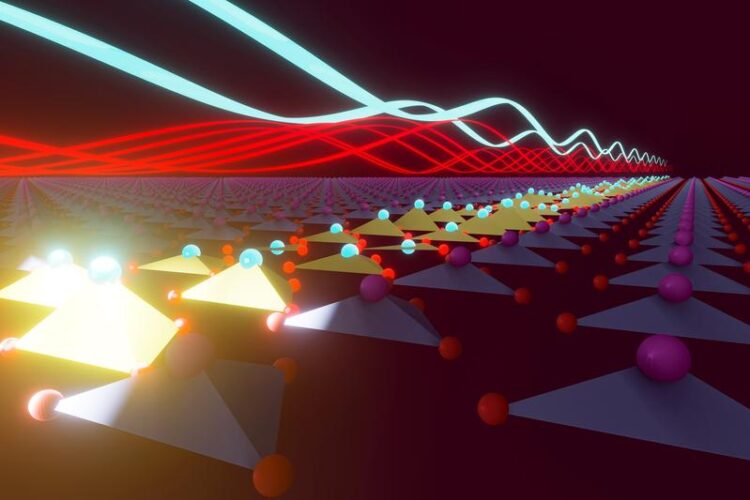A remote control for functional materials

An intense mid-infrared laser pulse hits a ferroelectric LiNbO3 crystal and kicks atomic vibrations only in a short depth below the surface.
Image: Joerg M. Harms / MPSD
Intense mid-infrared excitation has been demonstrated as a powerful tool for controlling the magnetic, ferroelectric and superconducting properties of complex materials. Nonlinear phononics is key to this end, as it displaces specific atoms away from their equilibrium positions to manipulate microscopic interactions. So far, this effect has been thought to occur only within the optically excited volume.
Now researchers in Hamburg discovered that the polarization reversal in ferroelectric lithium niobate (LiNbO3) even occurs in areas well away from the direct light ‘hit’. The hitherto unknown phenomenon – called nonlocal nonlinear phononics – has been published in Nature Physics.
Ferroelectric materials such as LiNbO3 possess a static electric polarization generated by lines of positive and negative charge that can be switched with an electric field. This unique property makes these materials the basic building block of many modern electronic components in smartphones, laptops and ultrasound imaging devices. Using laser light to change the ferroelectric polarization is a new approach that allows for extremely fast processes which would be a key step in the development of highly efficient ultrafast optical switches for new devices.
The researchers in Andrea Cavalleri’s group at the Max Planck Institute for the Structure and Dynamics (MPSD) used mid-infrared pulses to excite the surface of a LiNbO3 crystal, launching a strong vibration throughout a region that spans a depth of 3 micrometers from the crystal surface. Then, they used a technique called femtosecond stimulated Raman scattering to measure ultrafast changes of the ferroelectric polarization throughout the complete 50 micrometer crystal thickness. The measurements revealed that light pulses with a very high energy density cause the ferroelectric polarization to reverse throughout the entire crystal.
By using computational methods to simulate the effects of nonlinear phononics in LiNbO3, the authors found that strong polarization waves called polaritons emerge from the small volume traversed by the light pulse and move throughout the remaining depth of the crystal. These polariton waves are believed to play a significant role in altering the ferroelectric polarization throughout the sections of the crystal that are untouched by the light pulse.
The results reported by Henstridge et al. add an exciting new piece to the elusive puzzle of ultrafast ferroelectricity, the understanding of which can lead to new device components such as sustainable optical switches. More broadly, this work opens an enormous question concerning whether past and future systems driven by nonlinear phononics can exhibit a similar type of nonlocal character. The ability to manipulate functional properties at a distance could expand the realm of possibilities for incorporating nonlinear phononics into integrated devices and other complex materials, opening new avenues for controlling systems with light.
This research received support from the Deutsche Forschungsgemeinschaft via the Cluster of Excellence ‘The Hamburg Centre for Ultrafast Imaging’
Full figure caption:
An intense mid-infrared laser pulse hits a ferroelectric LiNbO3 crystal and kicks atomic vibrations only in a short depth below the surface, emphasized by the bright tetrahedra. Through anharmonic coupling, this strong vibration launches a polarization wave, also called polariton, which propagates throughout the remaining depth of the crystal to modulate the ferroelectric polarization.
Wissenschaftliche Ansprechpartner:
Dr. Michael Först
Senior Scientist
Max-Planck-Institut für Struktur und Dynamik der Materie
Luruper Chaussee 149, Geb. 99 (CFEL)
22761 Hamburg
Germany
michael.foerst@mpsd.mpg.de
Dr. Meredith A. Henstridge
(former MPSD Posdoc)
Research Assoc-Experimental
SLAC National Accelerator Laboratory
2575 Sand Hill Rd
Mailstop 00020
Menlo Park, California 94025 (USA)
mhenst@stanford.edu
Originalpublikation:
M. Henstridge, M. Först, E. Rowe, M. Fechner, und A. Cavalleri, Nonlocal nonlinear phononics, Nature Physics(2022).
https://dx.doi.org/10.1038/s41567-022-01512-3
Weitere Informationen:
https://doi.org/10.1038/s41567-022-01512-3 News & Views: “Controlling ferroelectricity below the surface” von E. Abreu
Media Contact
All latest news from the category: Physics and Astronomy
This area deals with the fundamental laws and building blocks of nature and how they interact, the properties and the behavior of matter, and research into space and time and their structures.
innovations-report provides in-depth reports and articles on subjects such as astrophysics, laser technologies, nuclear, quantum, particle and solid-state physics, nanotechnologies, planetary research and findings (Mars, Venus) and developments related to the Hubble Telescope.
Newest articles

Innovative 3D printed scaffolds offer new hope for bone healing
Researchers at the Institute for Bioengineering of Catalonia have developed novel 3D printed PLA-CaP scaffolds that promote blood vessel formation, ensuring better healing and regeneration of bone tissue. Bone is…

The surprising role of gut infection in Alzheimer’s disease
ASU- and Banner Alzheimer’s Institute-led study implicates link between a common virus and the disease, which travels from the gut to the brain and may be a target for antiviral…

Molecular gardening: New enzymes discovered for protein modification pruning
How deubiquitinases USP53 and USP54 cleave long polyubiquitin chains and how the former is linked to liver disease in children. Deubiquitinases (DUBs) are enzymes used by cells to trim protein…


